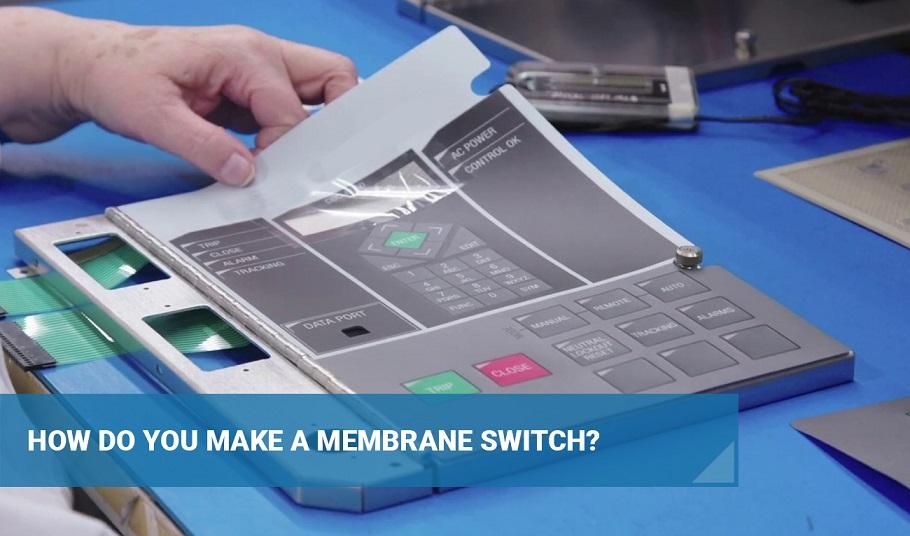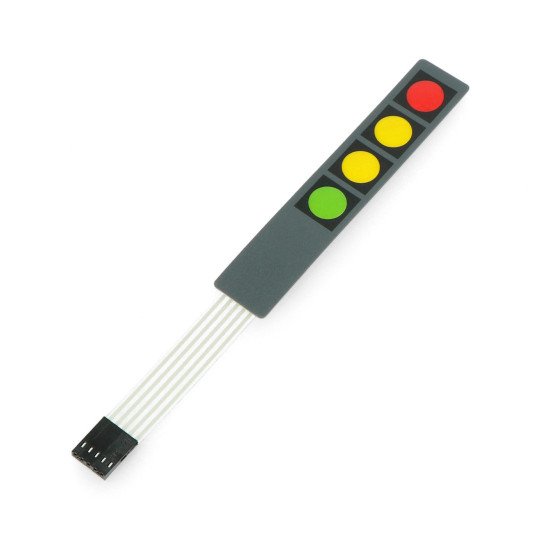Membrane Switch Manufacturer Serving Hospital and Military Industries
Membrane Switch Manufacturer Serving Hospital and Military Industries
Blog Article
Exploring the Manufacturing Process of Membrane Switch for Various Industries
The manufacturing procedure of Membrane buttons is a complicated undertaking that requires precision and attention to detail. From choosing suitable materials to executing rigorous quality assurance procedures, each action plays an important function in making sure performance. Various markets, including auto and clinical, rely on these parts for their special applications. Comprehending the details of this process reveals substantial insights into how these buttons are created and their impact throughout varied markets.
Understanding Membrane Changes: An Introduction

Key Products Used in Membrane Switch Production
In Membrane switch manufacturing, the selection of vital materials substantially affects functionality and longevity. Conductive materials, adhesives, and coverings play vital duties, while substrate selection impacts overall efficiency and integrity. Understanding these components is essential for maximizing the style and manufacturing of Membrane switches.
Conductive Products Overview
Conductive materials play an important role in the performance of Membrane buttons, making certain reliable electrical connections within the device. Frequently made use of materials include silver, copper, and carbon-based inks, each offering unique benefits. Silver is preferred for its high conductivity and resilience, making it suitable for applications requiring robust efficiency. Copper, while somewhat less conductive than silver, is a cost-effective option commonly used in printed circuits. Carbon-based inks provide a versatile alternative, ideal for applications where adaptability and lower costs are prioritized, although they have actually reduced conductivity contrasted to metal options. The option of conductive products directly impacts the total reliability, life expectancy, and performance of the Membrane switch, making it an important consideration in the manufacturing procedure.
Adhesives and Coatings
Finishings and adhesives are essential components in the manufacturing of Membrane switches, providing important bonding and protective residential or commercial properties. These materials guarantee that various layers of the button, including graphic overlays and wiring, stick safely to each other, improving resilience and performance. Typically utilized adhesives consist of pressure-sensitive adhesives (PSAs) and epoxy-based formulas, which provide strong bond and durability. Coatings, such as polyurethane or acrylic, serve to safeguard against environmental elements, consisting of wetness, abrasion, and chemicals. Furthermore, finishes can boost tactile feedback and aesthetic charm, adding to the general user experience. The choice of appropriate adhesives and coverings is vital for optimizing efficiency and durability in varied applications throughout different sectors, making certain that Membrane changes fulfill certain functional demands.
Substrate Option Aspects
Substrate choice plays a necessary function in the manufacturing of Membrane switches, as it significantly influences their overall performance and toughness. Trick products such as polyester, polycarbonate, and versatile published circuit card (FPCBs) are commonly used for their distinctive residential or commercial properties. Polyester is preferred for its cost-effectiveness and resistance to abrasion, making it appropriate for applications with high wear. Polycarbonate deals superior quality and impact resistance, ideal for settings needing high presence. FPCBs supply boosted adaptability and are commonly utilized in complicated styles. The option of substratum also impacts elements like thermal security, chemical resistance, and convenience of printing. Ultimately, selecting the proper substrate is vital for making certain the capability and long life of Membrane switches across numerous markets.
The Design Process of Membrane Switches Over
The layout process of Membrane buttons is a vital phase that substantially influences the performance and aesthetics of the last item - membrane switch manufacturer. It begins with defining the specific needs of the application, consisting of dimensions, button design, and responsive comments choices. Designers need to think about customer communication, making certain that the button is user-friendly and accessible.Next, materials are chosen based upon durability, flexibility, and ecological resistance. The assimilation of graphics and branding components is additionally important, as it enhances visual charm and communication. Prototyping permits repetitive testing, enabling adjustments based upon user feedback and efficiency evaluations.Additionally, the style must account for the electrical parts, such as circuits and adapters, making certain integrity and simplicity of use. Inevitably, an effective style harmonizes functionality, aesthetics, and user experience, leading the way for efficient production and lasting performance in numerous markets
Printing Strategies for Membrane Switches
The printing strategies used in Membrane switch manufacturing play a necessary role in figuring out the final item's top quality and functionality. Display printing provides benefits such as resilience and lively color application, while electronic printing innovations provide versatility and accuracy in style. Comprehending these methods can substantially affect the overall efficiency of Membrane switches in numerous applications.
Screen Printing Advantages
Various benefits make display printing a favored technique for producing Membrane switches. This approach permits high-grade, lively colors and comprehensive designs, which are vital for interface applications. Display printing is especially effective for applying thick ink layers, enhancing toughness and tactile feedback. Additionally, it uses superb bond to different substrates, guaranteeing longevity sought after settings. The procedure is cost-effective for huge manufacturing runs, as it reduces configuration time and waste. Moreover, screen printing sustains a vast array of inks, consisting of specialized and UV-curable choices, allowing versatility in design. Its capability to produce consistent outcomes across multiple units makes it a trusted selection for producers aiming for high quality and performance in Membrane button production.
Digital Printing Innovations

Innovations in digital printing innovation are changing the manufacturing of Membrane switches, providing makers innovative options that enhance design flexibility and performance. Digital printing permits high-resolution graphics and intricate styles, making it possible for custom-made branding and capability without the restrictions of conventional methods. This strategy minimizes configuration times and expenses, assisting in shorter production runs and marginal waste, making it ideal for organizations with differing demands. Additionally, developments in ink formulas give much better durability and bond, making certain durability in numerous settings. As industries progressively look for intricate and personalized designs, electronic printing stands out as a crucial method, establishing a new criterion in Membrane switch manufacturing. The integration of these developments placements suppliers to meet evolving market requires efficiently.
Setting up and Layering of Membrane Switch Parts
Careful assembly and layering of Membrane switch components are vital to ensuring performance and toughness. This procedure starts with the precise alignment of numerous layers, including the visuals overlay, adhesive, circuit layer, and support material. Each element should be carefully positioned to maintain electric honesty and individual interface responsiveness.During setting up, conductive traces are used to the circuit layer, commonly made from materials like polyester or polycarbonate. This layer is essential, as it sends signals when pressure is used. The glue utilized for bonding these layers is additionally selected for its capability to sustain ecological anxieties while keeping a safe bond.Heat and pressure are frequently applied during the assembly process to establish that the layers adhere properly without compromising the functionality of the button. Interest is provided to the side sealing to safeguard against moisture and contaminants, protecting the long life of the Membrane button in various commercial applications.
Quality Assurance Procedures in Membrane Switch Manufacturing
Quality control measures play a vital role in making sure the reliability and efficiency of Membrane switches over following the setting up and layering of their components. In the production procedure, a number of key examinations are conducted to promote high quality criteria. These consist of visual assessments for issues in printing and sticky application, as well as practical examinations to verify the responsiveness of each switch.Additionally, environmental testing is done to analyze the switches' toughness versus temperature level changes and moisture exposure. Producers frequently carry out analytical procedure control (copyright) techniques to keep an eye on production consistency, allowing very early discovery of anomalies.Furthermore, traceability systems are developed to track products and components, making certain accountability and helping with remembers if needed. Calibration of equipment and adherence to market requirements are additionally essential to maintaining item honesty. Jointly, blog these high quality control procedures protect the efficiency of Membrane switches over throughout numerous applications, inevitably boosting consumer complete satisfaction.
Applications of Membrane Changes Across Different Industries
Membrane switches are made use of across a diverse array of industries, showcasing their flexibility and adaptability. In the medical market, they supply dependable and waterproof interfaces for tools such as diagnostic tools and mixture pumps, making certain health and simplicity of usage. The automotive industry uses Membrane switches for control panel controls, making it possible for smooth interaction in between the driver and lorry systems.In customer electronics, these switches are discovered in appliances and handheld tools, supplying a streamlined, modern-day aesthetic while boosting performance. Industrial applications also utilize Membrane switches over for equipment control panels, where toughness and resistance to rough conditions are essential.Furthermore, the aerospace and defense sectors make use of Membrane buttons for cabin instrumentation and interaction systems, prioritizing integrity and performance under severe conditions. Overall, Membrane switches play an essential function in enhancing the individual experience and functional efficiency throughout numerous domains.
Frequently Asked Questions
For how long Does It Require To Make a Membrane Switch?
The manufacturing time for a membrane layer switch typically ranges from a couple of days to a number of weeks - membrane switch manufacturer. Aspects influencing this duration consist of design intricacy, product accessibility, and production quantity, all impacting the total timeline noticeably
What Is the Common Lifespan of a Membrane Layer Switch?
The typical lifespan of a membrane layer button generally varies from 1 to 5 million actuations, depending upon factors such as material top quality, environmental conditions, and use regularity, significantly affecting longevity and total efficiency.
Can Membrane Switches Be Customized for Particular Applications?
Membrane buttons can indeed be personalized for certain applications. Their style versatility enables alterations in size, shape, colors, and graphics, making certain compatibility with distinct requirements throughout numerous sectors and enhancing functionality and user experience.

Are Membrane Switches Over Ecologically Friendly?
The environmental influence of Membrane changes varies. Some materials made use of might not be green, while developments in making processes are progressively concentrating on sustainability, intending to reduce waste and promote recyclable parts in their production.
What Are the Typical Failure Settings of Membrane Buttons?
Typical failing settings of Discover More Membrane buttons include delamination, glue failing, deterioration from use, moisture ingress, and electric failures. These concerns can significantly impact capability, performance, and life-span in various applications throughout different markets. Membrane buttons can be customized to fit particular layout needs, such as form, capability, and dimension, making them highly adaptable.The building and construction typically involves several layers, consisting of a visuals next overlay, glue, and a circuit layer, which function with each other to create a seamless user experience. In Membrane button production, the selection of key products considerably affects performance and longevity. The automotive sector utilizes Membrane buttons for control panel controls, making it possible for seamless interaction between the driver and car systems.In customer electronics, these switches are found in devices and portable gadgets, offering a smooth, contemporary aesthetic while boosting performance. Industrial applications likewise take advantage of Membrane switches over for equipment control panels, where sturdiness and resistance to extreme conditions are essential.Furthermore, the aerospace and defense industries utilize Membrane switches for cabin instrumentation and interaction systems, prioritizing integrity and performance under extreme problems. Membrane buttons can undoubtedly be personalized for details applications.
Report this page